A) As the number of species on an island increases, the emigration rate decreases.
B) Competitive exclusion is less likely on an island that has large numbers of species.
C) Small islands receive few new immigrant species.
D) Islands closer to the mainland have higher extinction rates.
Correct Answer

verified
Correct Answer
verified
Multiple Choice
Red-cheeked salamanders are partially protected from predators because of cardiac glycosides they produce from glands on their back. When ingested, cardiac glycosides disrupt normal heart rhythms. A different salamander species, the imitator salamander, also has red cheek patches, but does not produce cardiac glycosides. It does gain protection from predators that have learned to avoid red-cheeked salamanders. How does this relationship affect the population dynamics of both species?
A) Both species are negatively affected.
B) Both species are positively affected.
C) The red-cheeked salamander is positively affected; the imitator is negatively affected.
D) The red-cheeked salamander is not affected; the imitator is positively affected.
Correct Answer

verified
Correct Answer
verified
Multiple Choice
Food chains are sometimes short because
A) only a single species of herbivore feeds on each plant species.
B) local extinction of a species causes extinction of the other species in its food chain.
C) most of the energy in a trophic level is lost as energy passes to the next higher level.
D) most producers are inedible.
Correct Answer

verified
Correct Answer
verified
Multiple Choice
If two species are close competitors, and one species is experimentally removed from the community, the remaining species would be expected to ________.
A) change its fundamental niche
B) decline in abundance
C) become the target of specialized parasites
D) expand its realized niche
Correct Answer

verified
Correct Answer
verified
Multiple Choice
Which of the following statements is consistent with the principle of competitive exclusion?
A) The random distribution of one competing species will have a positive impact on the population growth of the other competing species.
B) If two species have the same fundamental niche, one will exclude the other competing species.
C) Even a slight reproductive advantage will eventually lead to the elimination of the less well adapted of two competing species.
D) Natural selection tends to increase competition between related species.
Correct Answer

verified
Correct Answer
verified
Multiple Choice
Use the following diagram of five islands formed at around the same time near a particular mainland, as well as MacArthur and Wilson's island equilibrium model principles to answer the question.
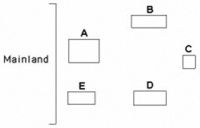 Which region would likely have the greatest species diversity?
Which region would likely have the greatest species diversity?
A) island A
B) island C
C) island D
D) the mainland
Correct Answer

verified
Correct Answer
verified
Multiple Choice
Use the figures to answer the following question.
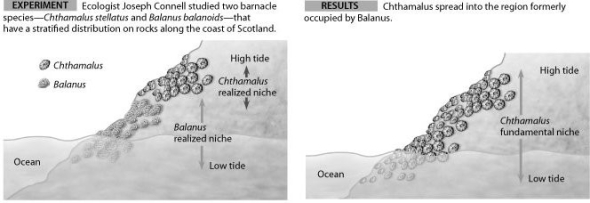 Connell conducted this experiment to learn more about ________.
Connell conducted this experiment to learn more about ________.
A) character displacement in the color of barnacles
B) habitat preference in two different species of barnacles
C) how sea-level changes affect barnacle distribution
D) competitive exclusion and distribution of barnacle species
Correct Answer

verified
Correct Answer
verified
Multiple Choice
Use the figure to answer the following question.
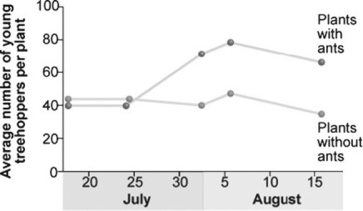 Treehoppers (a type of insect) produce honeydew, which ants use for food. Treehoppers have a major predator, the jumping spider. Researchers hypothesized that the ants would protect the treehoppers from the spiders. In an experiment, researchers followed study plots with ants removed from the system and compared them to a control plot. From the figure, what can you conclude?
Treehoppers (a type of insect) produce honeydew, which ants use for food. Treehoppers have a major predator, the jumping spider. Researchers hypothesized that the ants would protect the treehoppers from the spiders. In an experiment, researchers followed study plots with ants removed from the system and compared them to a control plot. From the figure, what can you conclude?
A) Ants do somehow protect the treehoppers from spiders.
B) Ants eat the honeydew produced by treehoppers.
C) Ants reduce the numbers of treehoppers.
D) No specific conclusions can be drawn from this figure.
Correct Answer

verified
Correct Answer
verified
Multiple Choice
Use the following diagram of five islands formed at around the same time near a particular mainland, as well as MacArthur and Wilson's island equilibrium model principles to answer the question.
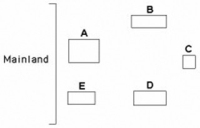 Which island would likely have the lowest extinction rate?
Which island would likely have the lowest extinction rate?
A) A
B) C
C) D
D) E
Correct Answer

verified
Correct Answer
verified
Multiple Choice
How might an ecologist test whether a species is occupying all of its fundamental niche or only a portion of it?
A) Study the temperature range and humidity requirements of the species.
B) Observe if the species expands its range after the removal of a competitor.
C) Measure the change in reproductive success when the species is subjected to environmental stress.
D) Observe if the niche size changes after the introduction of a similar non-native species.
Correct Answer

verified
Correct Answer
verified
Multiple Choice
Approximately how many kilograms (kg) of carnivore (secondary consumer) biomass can be supported by a field plot containing 1000 kg of plant material?
A) 1000
B) 100
C) 10
D) 1
Correct Answer

verified
Correct Answer
verified
Multiple Choice
Use the figure to answer the following question.
 The figure proposes a combination of a top-down and bottom-up model (a hypothesis) to describe the variable effects of biological control herbivores on the fitness (growth and reproduction) of an invasive, non-native plant, spotted knapweed (Centaurea stoebe) . These herbivores include multiple insects that were first studied in the plant's native home range in eastern Europe, where the plant is not dominant in grassland communities and does not pose a problem to land managers and conservationists. Many insects there were found to consume the plant's tissues, including stems, leaves, and seeds, and some were very host specific and were not found to attack plants other than C. stoebe. Several insects were subsequently transported and released in an attempt to reduce densities of this non-native and problematic weed in the United States. The y-axis shows C. stoebe plant fitness, and the x-axis represents the intensity of herbivory by the insects, from low to high. As the vertical shaded bar is moved along the x-axis, the ultimate effect of herbivory (now A, B, and C) on plant fitness can change based on its intensity and also may depend on the other factors. The horizontal dashed line represents no predicted change in fitness under the effects of varying intensity of herbivory, plant competition, and soil resources available to the plant (such as nitrogen or water) , while the three solid lines represent other possible outcomes.
(D) G. Knochel and T.R. Seastedt. 2011. Reconciling contradictory findings of herbivore impacts on spotted knapweed (Centaurea stoebe) growth and reproduction. Ecological Applications 20(7) :1903-1912.
What is the model's prediction for C. stoebe plant fitness when growing under high soil resource conditions?
The figure proposes a combination of a top-down and bottom-up model (a hypothesis) to describe the variable effects of biological control herbivores on the fitness (growth and reproduction) of an invasive, non-native plant, spotted knapweed (Centaurea stoebe) . These herbivores include multiple insects that were first studied in the plant's native home range in eastern Europe, where the plant is not dominant in grassland communities and does not pose a problem to land managers and conservationists. Many insects there were found to consume the plant's tissues, including stems, leaves, and seeds, and some were very host specific and were not found to attack plants other than C. stoebe. Several insects were subsequently transported and released in an attempt to reduce densities of this non-native and problematic weed in the United States. The y-axis shows C. stoebe plant fitness, and the x-axis represents the intensity of herbivory by the insects, from low to high. As the vertical shaded bar is moved along the x-axis, the ultimate effect of herbivory (now A, B, and C) on plant fitness can change based on its intensity and also may depend on the other factors. The horizontal dashed line represents no predicted change in fitness under the effects of varying intensity of herbivory, plant competition, and soil resources available to the plant (such as nitrogen or water) , while the three solid lines represent other possible outcomes.
(D) G. Knochel and T.R. Seastedt. 2011. Reconciling contradictory findings of herbivore impacts on spotted knapweed (Centaurea stoebe) growth and reproduction. Ecological Applications 20(7) :1903-1912.
What is the model's prediction for C. stoebe plant fitness when growing under high soil resource conditions?
A) Plant fitness decreases as a result of low intensity herbivory.
B) Plant fitness increases under all levels of intensity of herbivory.
C) Plant fitness decreases only if the intensity of herbivory is very high.
D) Plant fitness does not change.
Correct Answer

verified
Correct Answer
verified
Multiple Choice
Which of the following is an example of aposematic coloration?
A) a non-poisonous snake mimics the color of a poisonous one
B) the brightly colored patterns of monarch butterfly caterpillars
C) green color of a plant
D) a katydid whose wings look like a dead leaf
Correct Answer

verified
Correct Answer
verified
Multiple Choice
Which of the following measurements would be most helpful in understanding the structure of an ecological community? I. determining how many species are present overall II. determining which particular species are present III.determining the kinds of interactions that occur among individuals of the same species IV.determining the abundance of resources available for one species
A) only I and II
B) only II and IV
C) only I, II, and III
D) I, II, III, and IV
Correct Answer

verified
Correct Answer
verified
Multiple Choice
Which of the following is an example of a commensalism?
A) fungi residing in plant roots, such as endomycorrhizae
B) bacteria fixing nitrogen on the roots of some plants
C) rancher ants that protect aphids in exchange for sugar-rich honeydew
D) cattle egrets eating insects stirred up by grazing bison
Correct Answer

verified
Correct Answer
verified
Multiple Choice
The symbols +, -, and 0 are used to show the results of interactions between individuals and groups of individuals. The symbol + denotes a positive interaction, - denotes a negative interaction, and 0 denotes interactions in which individuals are not affected. The first symbol refers to the first organism mentioned. What interactions exist between a lion pride and African wild dogs, if the dogs are found to typically avoid areas with lions?
A) +/+
B) +/-
C) 0/0
D) -/-
Correct Answer

verified
Correct Answer
verified
Multiple Choice
Which of the following is an example of Batesian mimicry?
A) a butterfly that resembles a leaf
B) a nonvenomous larva of a moth that moves like a venomous snake
C) a fawn with fur coloring that camouflages it in the forest environment
D) a snapping turtle that uses its tongue to mimic a worm, thus attracting fish
Correct Answer

verified
Correct Answer
verified
Multiple Choice
Use the figure to answer the following question.
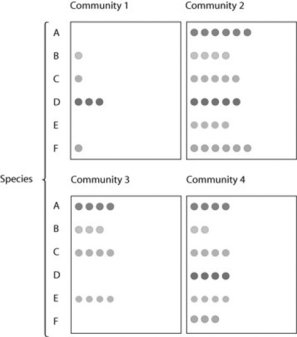 In the figure, imagine that community 4 represents a marine community off the coast of Florida, where overfishing of a particular trophy fish (imagine a species G. for two decades gradually shifted it to resemble community 3. The species that was overfished was likely ________.
In the figure, imagine that community 4 represents a marine community off the coast of Florida, where overfishing of a particular trophy fish (imagine a species G. for two decades gradually shifted it to resemble community 3. The species that was overfished was likely ________.
A) an invasive species
B) a keystone species
C) a primary producer
D) species A, B, C, E, and F
Correct Answer

verified
Correct Answer
verified
Multiple Choice
Use the following diagram of a hypothetical food web to answer the question. The arrows represent the transfer of energy between the various trophic levels.
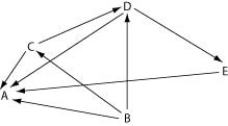 Which letter represents an organism that could be a producer?
Which letter represents an organism that could be a producer?
A) A
B) B
C) D
D) E
Correct Answer

verified
Correct Answer
verified
Multiple Choice
Based on the intermediate disturbance hypothesis, a community's species diversity is increased by ________.
A) frequent immigrations of new species
B) stable conditions with no disturbance
C) moderate levels of disturbance
D) intensive disturbance by humans
Correct Answer

verified
Correct Answer
verified
Showing 41 - 60 of 71
Related Exams